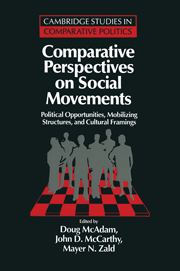 Comparative Perspectives on Social Movements
Comparative Perspectives on Social Movements Published online by Cambridge University Press: 05 June 2012
Political opportunity theorists have mainly dealt with mobilization for protest as the primary dependent variable. Opportunities were clearly assets of their environment and not properties of the protest groups themselves. Thus, the crucial question was: “Which opportunities facilitate or restrict the kind and/or extent of mobilization?” Some authors have treated the level of mobilization (Kriesi, 1989b, 1991; Tarrow, 1989b, 1991b) or the strengths of movements (Rucht, 1995) as the dependent variable. Others focused more specifically on movement strategies (Eisinger, 1973; Kitschelt, 1986), behavior (della Porta and Rucht, 1991), or outcomes (Kitschelt, 1986). Underlying all this work is the explicit or implicit assumption that external opportunities have a direct effect on these dependent variables. However, the literature neglects the role of the structural basis for mobilization. This is surprising, because few social movement scholars doubt that movement networks and organizations have a strong impact on strategies, mobilization, and success.
Resource mobilization theorists have emphasized the role of social movement industries, movement organizations, and movement entrepreneurs in the process of mobilization (Zald and Ash, 1966; McCarthy and Zald, 1977; Zald and McCarthy, 1980). They have not only formulated a variety of hypotheses about these explanatory factors for mobilization as the dependent variable but also demonstrated their weight in many empirical studies. However, not much work in this research tradition analyzes the societal context that may influence social movement organizations (but see Garner and Zald, 1985; McCarthy, Britt, and Wolfson, 1991). As a rule, political opportunity approaches have neglected the structural basis for resource mobilization, whereas resource mobilization approaches have largely ignored the broader political environments in which social movement organizations are embedded.
To save this book to your Kindle, first ensure no-reply@cambridge.org is added to your Approved Personal Document E-mail List under your Personal Document Settings on the Manage Your Content and Devices page of your Amazon account. Then enter the ‘name’ part of your Kindle email address below. Find out more about saving to your Kindle.
Note you can select to save to either the @free.kindle.com or @kindle.com variations. ‘@free.kindle.com’ emails are free but can only be saved to your device when it is connected to wi-fi. ‘@kindle.com’ emails can be delivered even when you are not connected to wi-fi, but note that service fees apply.
Find out more about the Kindle Personal Document Service.
To save content items to your account, please confirm that you agree to abide by our usage policies. If this is the first time you use this feature, you will be asked to authorise Cambridge Core to connect with your account. Find out more about saving content to Dropbox.
To save content items to your account, please confirm that you agree to abide by our usage policies. If this is the first time you use this feature, you will be asked to authorise Cambridge Core to connect with your account. Find out more about saving content to Google Drive.